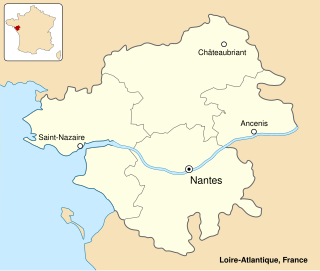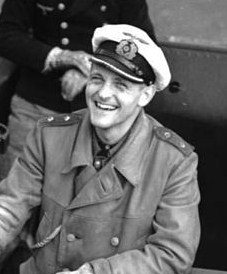
The St Nazaire Raid or Operation Chariot was a British amphibious attack on the heavily defended Normandie dry dock at St Nazaire in German-occupied France during the Second World War. The operation was undertaken by the Royal Navy (RN) and British Commandos under the auspices of Combined Operations Headquarters on 28 March 1942. St Nazaire was targeted because the loss of its dry dock would force any large German warship in need of repairs, such as Tirpitz, sister ship of Bismarck, to return to home waters by running the gauntlet of the Home Fleet of the Royal Navy and other British forces, via the English Channel or the North Sea.

USS Buchanan (DD-131), named for Franklin Buchanan, was a Wickes-class destroyer in the United States Navy.

German submarine U-47 was a Type VIIB U-boat of Nazi Germany's Kriegsmarine during World War II. She was laid down on 25 February 1937 at Friedrich Krupp Germaniawerft in Kiel as yard number 582 and went into service on 17 December 1938 under the command of Günther Prien.

HMS Campbeltown was a Town-class destroyer of the Royal Navy during the Second World War. She was originally US destroyer USS Buchanan, and was one of 50 obsolescent U.S. Navy destroyers transferred to the Royal Navy in 1940 as part of the Destroyers for Bases Agreement. Campbeltown became one of the most famous of these ships when she was used in the St Nazaire Raid in 1942.

Erich Topp was a German U-boat commander of World War II. He was a recipient of the Knight's Cross of the Iron Cross with Oak Leaves and Swords of Nazi Germany. He sank 35 ships for a total of 197,460 gross register tons (GRT). After the war, he served with the Federal German Navy, reaching the rank of Konteradmiral. He later served in NATO.

The 1st U-boat flotilla also known as the Weddigen flotilla, was the first operational U-boat unit in Nazi Germany's Kriegsmarine (navy). Founded on 27 September 1935 under the command of Fregattenkapitän Karl Dönitz, it was named in honor of Kapitänleutnant Otto Weddigen. Weddigen, a U-boat commander during World War I, died on 18 March 1915 after his submarine U-29 was rammed by the British battleship HMS Dreadnought in the North Sea.

The 2nd U-boat Flotilla, also known as the Saltzwedel Flotilla, was the second operational U-boat unit in Nazi Germany's Kriegsmarine. Founded on 1 September 1936 under the command of Fregattenkapitän Werner Scheer, it was named in honour of Oberleutnant zur See Reinhold Saltzwedel. Saltzwedel, a U-boat commander during World War I, died on 2 December 1917, when his submarine UB-81 was sunk by a mine in the English Channel.

A depot ship is an auxiliary ship used as a mobile or fixed base for submarines, destroyers, minesweepers, fast attack craft, landing craft, or other small ships with similarly limited space for maintenance equipment and crew dining, berthing and relaxation. Depot ships may be identified as tenders in American English. Depot ships may be specifically designed for their purpose or be converted from another purpose.

The 3rd U-boat Flotilla, also known as Lohs Flotilla, was the third operational U-boat unit in Nazi Germany's Kriegsmarine. Founded on 4 October 1937 under the command of Kapitänleutnant Hans Eckermann, it was named in honour of Oberleutnant zur See Johannes Lohs. Lohs, a U-boat commander during World War I, died on 14 August 1918 after his submarine UB-57 was sunk by a mine.

The 9th U-boat Flotilla was formed in October 1941 in Brest. It became operational in April 1942, after the first combat ready U-boat, U-213, reached the Brest base on 20 March 1942. The flotilla operated mostly various marks of the Type VII U-boat and it concentrated its efforts mainly in the North Atlantic, against convoys to and from Great Britain. The flotilla served from Brest until the base was threatened with being captured by American forces. The last of the flotilla's U-boats, the U-256 left Brest on 4 September 1944 for Bergen, Norway, and this marked the end of the 9th Flotilla. All its surviving boats were reassigned to the 11th U-boat Flotilla in Bergen.

The 6th U-boat Flotilla, also known as Hundius Flotilla, was a front-line unit of Nazi Germany's Kriegsmarine before and during World War II.

German submarine U-46 was a Type VIIB U-boat of Nazi Germany's Kriegsmarine during World War II. She had a highly successful career during the war.

Helmut Rosenbaum was a Korvettenkapitän in Nazi Germany's Kriegsmarine during World War II who commanded U-boat U-2, U-73 and the 30th U-boat Flotilla. He received the Knight's Cross of the Iron Cross, awarded to recognize extreme battlefield bravery or successful military leadership. He is credited with the sinking of six ships for a total of 35,171 gross register tons (GRT) and three warships.

Jost Metzler was a German submarine commander during World War II. He commanded the U-boats U-69 and U-847, and was recipient of the Knight's Cross of the Iron Cross of Nazi Germany.
German submarine U-229 was a Type VIIC U-boat of Nazi Germany's Kriegsmarine during World War II.

HMS Tynedale was a Hunt-class destroyer of the first subgroup which served during the Second World War. She was sunk by the U-593 on 12 December 1943.
German submarine U-410 was a Type VIIC U-boat built for Nazi Germany's Kriegsmarine during World War II, operating mainly in the Mediterranean. Her insignia was a sword & shield, she did not suffer any casualties until she was sunk.
German submarine U-206 was a Type VIIC U-boat of the Kriegsmarine during World War II. The submarine was laid down on 17 June 1940 by the Friedrich Krupp Germaniawerft yard at Kiel as yard number 635, launched on 4 April 1941 and commissioned on 17 May under the command of Oberleutnant zur See Herbert Opitz.
German submarine U-385 was a Type VIIC U-boat of Nazi Germany's Kriegsmarine during World War II.
German submarine U-454 was a Type VIIC U-boat of Nazi Germany's Kriegsmarine during World War II.














